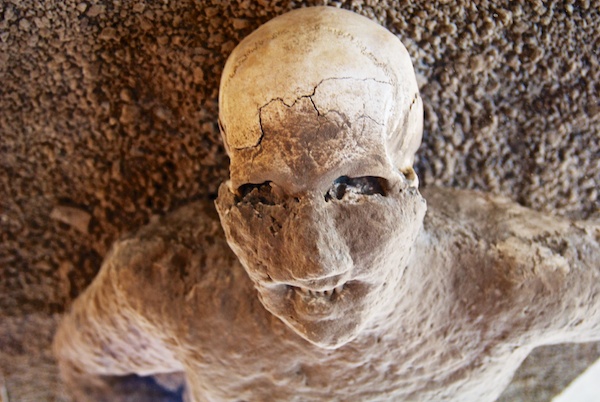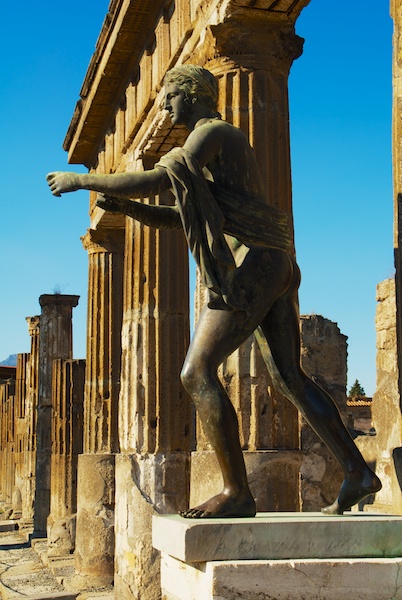Science, Photography, and Trip Reviews
.
Pompeii
Mount Vesuvius, extensive ruins, & victims
Upscale houses and Roman baths
Art works: Paintings, mosaics, & frescoes
|
Ruins from the eruption with Mount Vesuvius seen in the background. |
Contact Us
Southern Italy pages: Rome to Rome
We were on a Globus escorted tour that included Rome and Southern Italy. An overview of the tour is given in the Introduction. The tour started in Romewhere visits included the Coliseum, Vatican, and the Spanish Steps. We then went south to Naples, Sorrento, and the Isle of Capri. The sights seen are described in the page for Southern Italy (mainland). We also toured Pompeii. Although Pompeii is part of Southern Italy, it is important enough to deserve a separate page. That part of the tour is described here. From Naples we took an overnight boat to Sicily where sights visited included Palermo, Taormina, and Mount Etna. From Sicily we went back to Southern Italy (mainland) where we saw the Caves of Castellana and Alberobello. The tour ended in Rome. Contact Us for more information.
Eruption of Mount Vesuvius
Pompeii was destroyed by a volcanic eruption of Mount Vesuvius in 79 A.D. It is an incredibly fascinating place. In the picture at the top of this page Mount Vesuvius can be seen in the distance behind the ruins. Another view of the ruins is shown below.
|
Pompeii ruins. |
Ancient cities are usually heavily looted, buildings are destroyed to make room for new buildings, or materials are carried away to be used in building something somewhere else. This makes it difficult to decipher the history of ancient cities. The ruins of Pompeii are different since after the eruption the city was covered by volcanic debris to a depth of about 21 feet (6 meters). This cover preserved much of the destroyed city. The best way to see Pompeii is to walk the streets. Note the pictures below.;
|
A long street in Pompeii. |
|
There are many streets to walk in Pompeii. |
Discovery of Pompeii
Pompeii was discovered in the sixteenth century while excavating for a canal. However, serious excavations did not commence until around 1860. Of all of the ruins this is the largest excavated site.
|
Plaster cast of Vesuvius victim. |
At the time of the eruption the area of Pompeii was about 160 acres. The population of the city could have been in excess of 30,000 people. Eerie plaster casts of victims of the eruption, such as the one shown above, can be seen in Pompeii.
|
A life-size statue. |
Life in Pompeii
The sea was much closer to Pompeii during its existence. As a result, Pompeii was a thriving port city with many different kinds of businesses and services offered. The center for business, politics, and religion was the forum. For entertainment people went to the amphitheater to see the gladiators fight. Walking the streets of Pompeii you see statues such as the life-size statue shown above.
|
Roman bath. |
Baths and brothels were very important to the ancient Romans and were scattered throughout the city. A Roman bath is seen above. Baths were also found in private homes. Underground furnaces were used to heat the water in the baths. The walls of baths and brothels contain scenes some of which are very erotic in nature and can be seen today.
|
Upscale house. |
The homes of the wealthy, an example of which is seen above, might contain inner courtyards, gardens with fountains, and marble statues. Floors and walls are found with marble tiles, mosaics, or frescoes. The homes can be quite large, with one taking up an entire city block. There are also numerous smaller homes, and some were shop-homes where people lived in the back. The houses had drain tile to carry away the waste and water was brought in by lead pipe. Note the pictures below. People may have been poisoned by the lead in the pipes.
|
Drain tile in house. |
|
Lead pipe for carrying water to houses. |
How to see Pompeii
You can see Pompeii by walking around on your own. However, it is better to have an official guide since they can take you to restricted areas that individuals are not allowed to visit by themselves. Many works of art and other items from Pompeii are now found in the National Archaeological Museum in Naples .
Southern Italy pages: Rome to Rome
We were on a Globus escorted tour that included Rome and Southern Italy. An overview of the tour is given in the Introduction. The tour started in Romewhere visits included the Coliseum, Vatican, and the Spanish Steps. We then went south to Naples, Sorrento, and the Isle of Capri. The sights seen are described in the page for Southern Italy (mainland). We also toured Pompeii. Although Pompeii is part of Southern Italy, it is important enough to deserve a separate page. That part of the tour is described here. From Naples we took an overnight boat to Sicily where sights visited included Palermo, Taormina, and Mount Etna. From Sicily we went back to Southern Italy (mainland) where we saw the Caves of Castellana and Alberobello. The tour ended in Rome.
Photos by Sunny Breeding. We sell images and prints.









